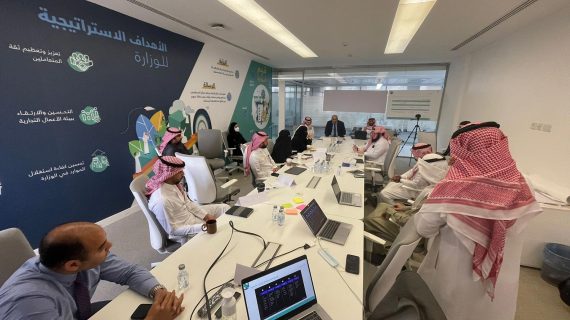...
Established 1990
+966112495943
Email: info@arrowad.sa
Arrowad International Group
P.O.Box 90987, Uthman Ibn Affan, AtTaawn, Riyadh 11623, KSA
The Major Transformations in Quality... Opportunities and Challenges!
It's no secret to experts in the field of quality that it has evolved for over a century and continues to evolve to this moment, from the early steps of quality, which focus on inspection and control, to our current era of digital transformation and emphasis on value for all stakeholders, new horizons are possible with emerging technologies, with artificial intelligence being one of the most prominent. In our article, let's explore how the concept of quality has evolved over time, what are the key challenges and opportunities for the future, and how quality practitioners and enthusiasts can play a crucial role in leading and supporting the necessary transformations to maximize the benefits of these developments.
16 Shawwal 1444, corresponding to May 6, 2023.
Article Series on Quality.
There is no denying that there are intrinsic overlaps and functional relationships between each of the five fundamental transformations of quality, which will be presented here. Moving chronologically to the latest does not mean closing the chapter of what preceded it! Let's briefly outline these five fundamental quality transformations:
Quality Inspection:
This stage dates to the late 19th and early 20th centuries when Frederick Taylor, known as the pioneer of scientific management, emphasized the importance of quality inspection as a means of measurement to detect errors in production. The focus was on discovering defects and correcting them after they occurred, rather than preventing them."
Quality Control:
This stage emerged between 1920 and 1950 when statistical methods were introduced to monitor and control variations in production processes. The focus of quality shifted from concepts and mechanisms of inspection to preventive concepts for the first time in the world of quality! Quality became the responsibility of engineers and specialized technicians. During this period, Walter Shewhart, known as the pioneer of Statistical Process Control (SPC), developed the Control Chart as a tool for analysing and improving process performance. However, the focus still naturally remained on product quality.
Quality Assurance:
This stage evolved between 1950 and 1970 when quality became a factor to enhance competitiveness and achieve customer satisfaction. The focus expanded from product quality to the quality of processes. Pioneers of this stage included Edward Deming, Joseph Juran, and Philip Crosby. The emphasis continued process planning systematically to prevent errors and deviations. Statistical control methodologies evolved into comprehensive statistical control methodologies at the organizational operational level.
Quality Management:
This stage emerged between 1970 and 2000 when quality became a critical concern for organizations. The focus expanded from the quality of production processes to the overall system quality and continuous improvement of all its elements. Quality became the responsibility of leaders and managers. During the same period, there was a call to embrace Total Quality Management (TQM) as a culture and philosophy that centers on people as valuable assets to be invested in. It engages all members of the organization in continuous improvement processes, customer satisfaction, employee empowerment, teamwork, and leadership.
The Japanese model of quality management, based on concepts such as Kaizen, Gemba, Hoshin Kanri, and other supporting tools, had a significant impact during this stage. The International Organization for Standardization (ISO) announced its international standard (ISO 9001), and the Malcolm Baldrige National Quality Award was launched in the United States. The European Foundation for Quality Management (EFQM) also introduced its model for organizational change management as a general framework that pushes maturity of practices and excellence towards achieving distinction.
The Strategic Context of Quality Management:
This stage unfolded at the beginning of the 21st century and continues to the present, where quality becomes a proactive driver of change. This shift was not complete until the focus of quality management expanded from operations to the strategic level of organizations. The International Organization for Standardization (ISO) introduced the High-Level Structure (HLS) for management system standards in 2012, signaling a shift towards studying the organizational context first.
The organizational context involves understanding and studying the internal and external scopes influencing quality management within the organization. This includes its strategic directions, understanding and analyzing the needs and expectations of stakeholders. Based on this understanding, the scope and processes are determined, followed by defining leadership requirements before planning, operation, performance evaluation, and improvement requirements. This elevated the focus of quality management to the strategic level, as a result, all management system standards, including the Quality Management System, were updated in 2015 according to the unified strategic-oriented structure. Following this, the European Foundation for Quality Management (EFQM) released its latest version of the Change Management Support Model for Organizations (EFQM 2020). This model is based on three axes: Direction, Deployment, and Results. The Direction axis involves a strategic dimension, encompassing a comprehensive understanding and study of the ecological system of the organization, including its internal, local, external, and global scopes. The emergence of digital transformation in this stage of quality management has facilitated the utilization of emerging digital technologies such as artificial intelligence, big data analytics, cloud computing, the Internet of Things, blockchain, and others, to enhance performance quality, customer experience, innovation, and sustainability.
Certainly, practitioners and experts in quality management will play an increasingly crucial role in this final stage by involving and educating people, often leading transformation processes. In this stage, quality management faces challenges and opportunities, including:
- Aligning quality objectives with the strategic vision and organizational goals to create real value for all stakeholders.
- Adapting to changing customer expectations and needs in a dynamic and complex environment.
- Promoting a quality improvement culture that embraces change, learning, and collaboration.
- Integrating appropriate digital technologies into quality strategies, systems, and processes to enhance efficiency, effectiveness, and flexibility.
- Developing new skills and competencies for quality professionals to deal with digital transformation and innovation mechanisms and tools.
To address these challenges and seize opportunities, quality management experts need to rely on a comprehensive and proactive approach that considers not only the technical and technological aspects of product and service quality, processes, systems, and assets but also the human aspects. Establishing an organizational culture supportive of change is essential, as transformation cannot occur without a parallel shift in people's mindset, relationships, and the culture of continuous improvement.

Mohammad Elbanna
Senior Consultant





![valuepoسst03-01 [Recovered]-02](https://arrowad.sa/wp-content/uploads/2023/06/valuepoسst03-01-Recovered-02-54x54_c.png)


